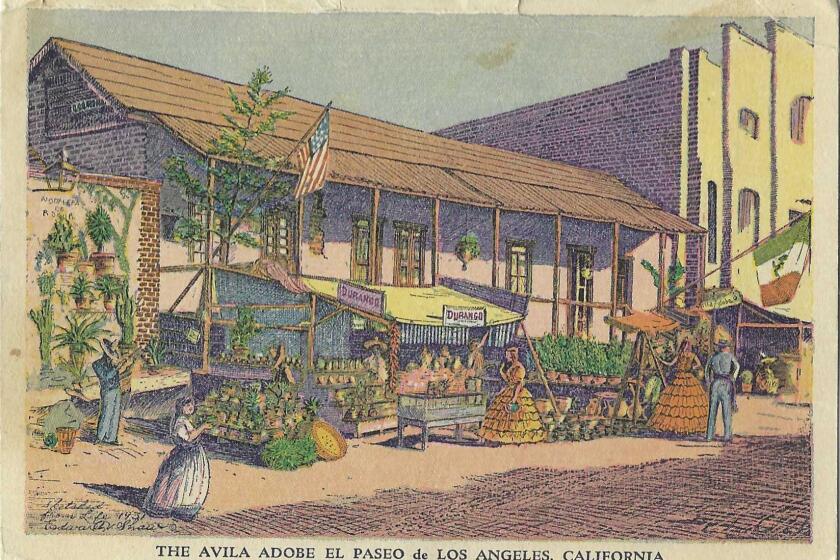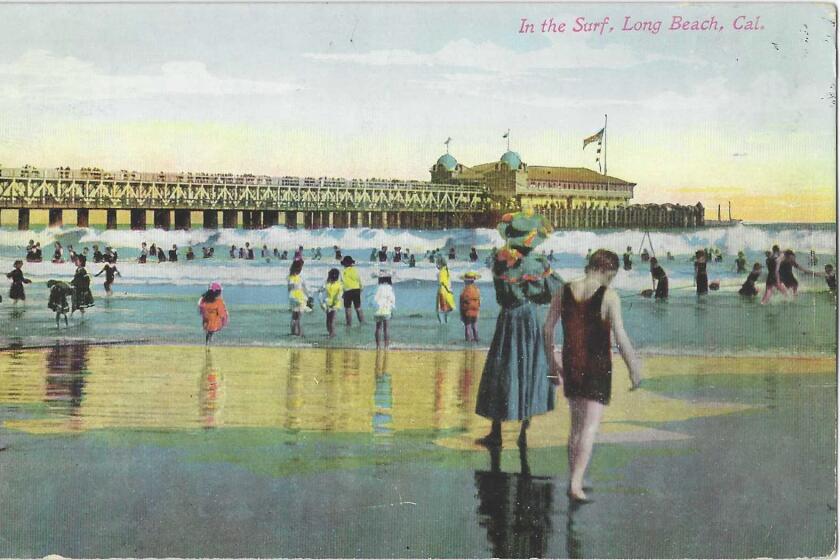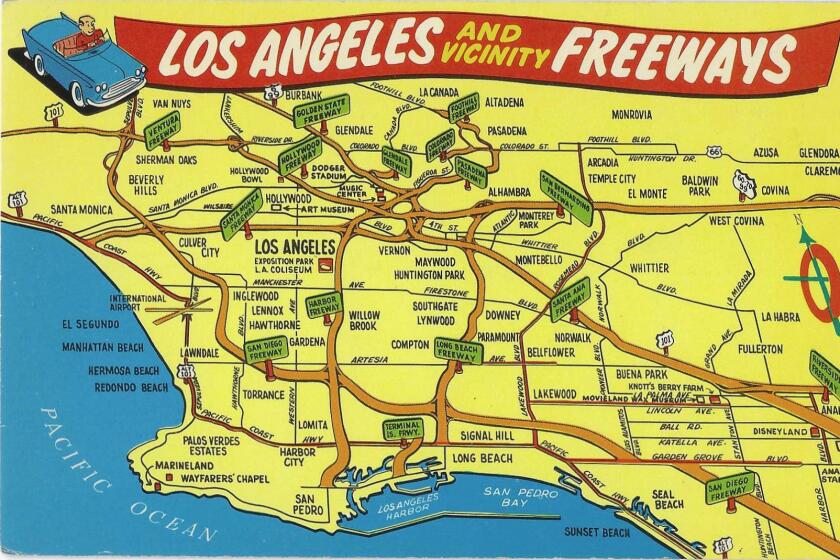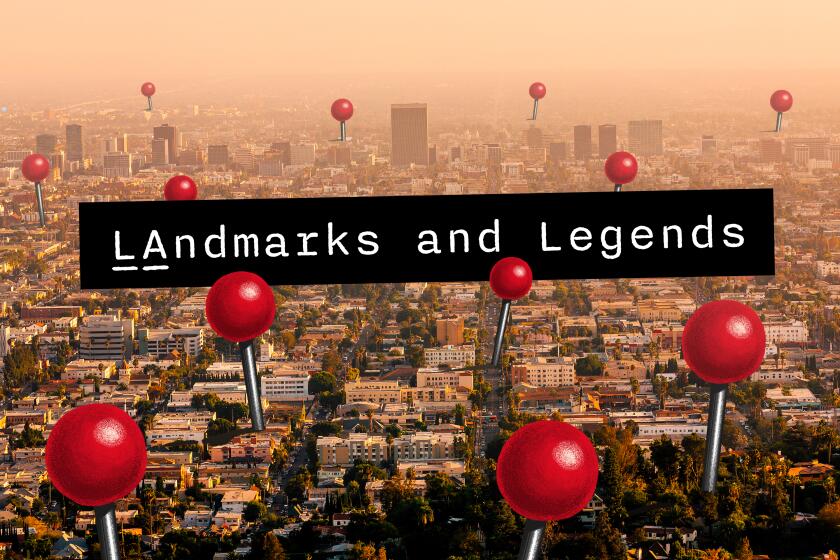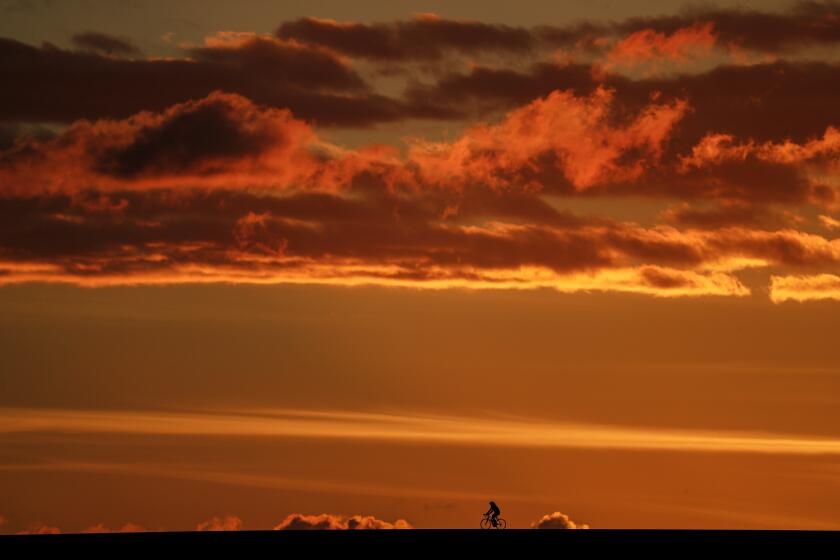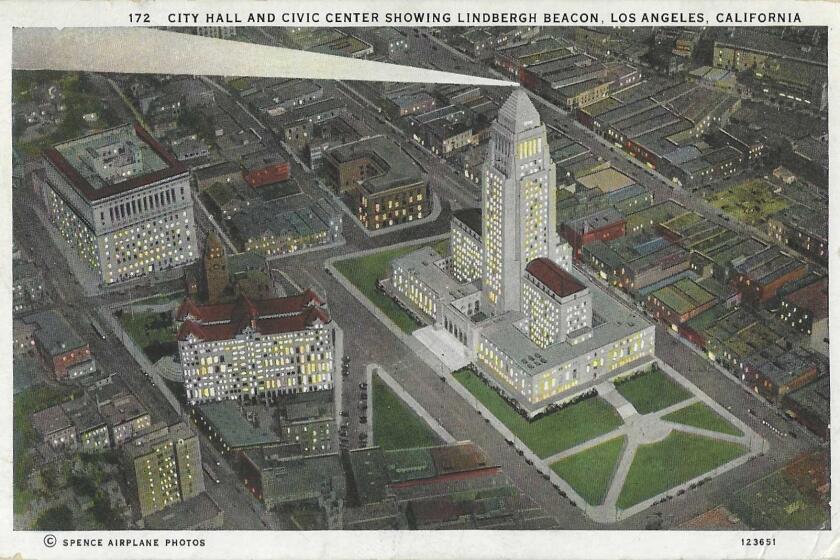Who gets to be an Angeleno? Lots of people, and that’s a good thing
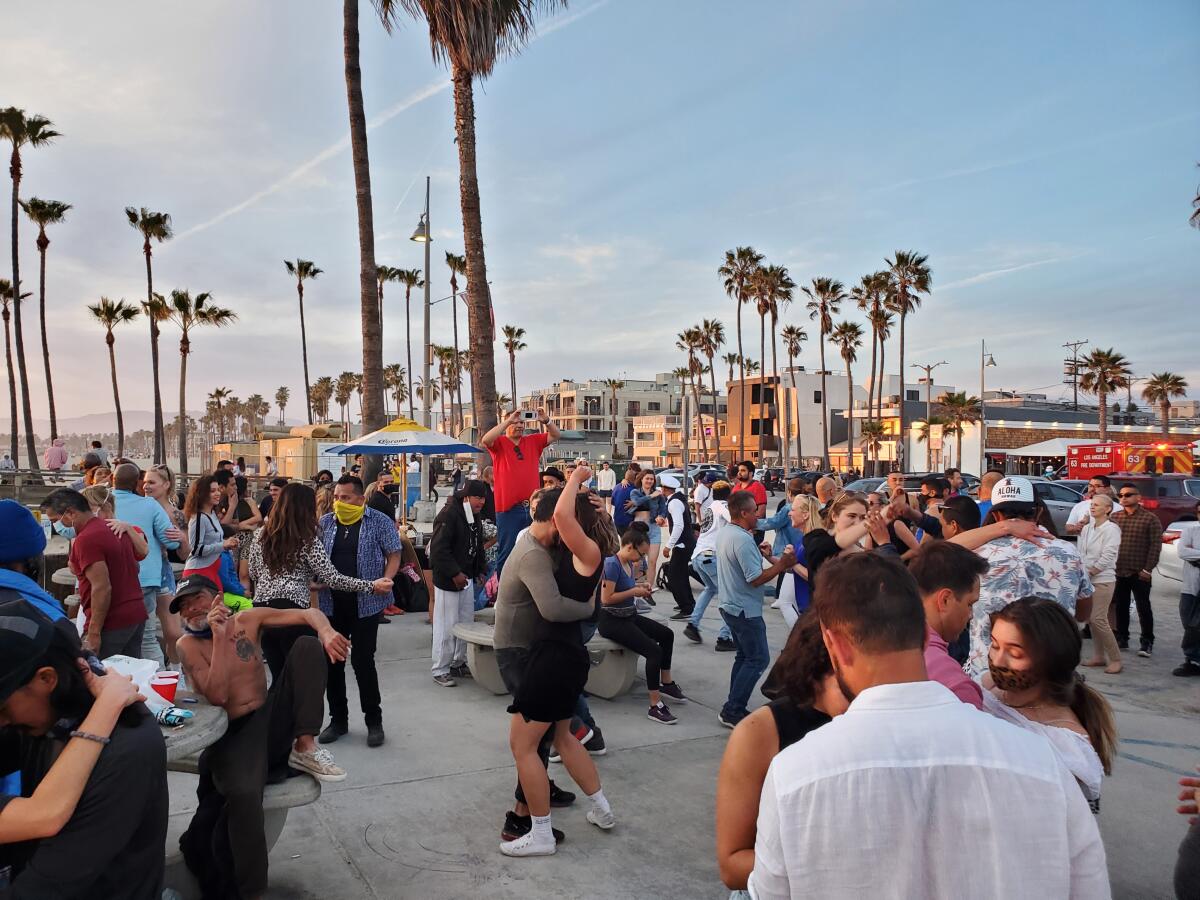
- Share via
This column is about asking a question, not about settling one.
So hitch your chair on up and chime in: What does it take to be an Angeleno?
It’s more than your address, but what else? There’s no test to pass, no license to qualify for. So how do you know when you are one? Does it happen gradually? Or all at once, in a coup de foudre, a lightning strike of, “Hey, this is my town!”?
Me, I don’t put a stopwatch on anyone. I always say there are two sorts of Angelenos: the ones lucky enough to be born here, and those smart enough to move here. Living here a few weeks is enough to make some people into authentic Angelenos; others can be born here but remain strangers to their hometown.
Mona Holmes believes that too. She is a reporter for EaterLA and grew up in Altadena and Pasadena, with a vision of L.A. that, like her palate, is ecumenical. “To be a good community member you have to contribute to it and not be a taker. I know some people who have lived here forever and are takers. If you are a transplant and you come here, embrace all of the imperfections of this place — because there are many — while bringing all you are and have to the betterment of this place, you absolutely can be an Angeleno.”
And please, please, she begs you — don’t complain about traffic. It’s so boring. There are millions of us, and everyone has a traffic story. Figure out some good routes, make a stop at a new restaurant en route. Strike out on a different path. Look around. Don’t just be in L.A. — be of it. Go beyond the city borders, she says, south, east, north. “This place is so big — it’s never-ending. So why not be an explorer in this wonderful city of ours?”
Through her prism of food, Holmes encounters people who refuse to take what the place has and instead gripe about what it doesn’t. “I hear it about food all the time: ‘We don’t have Southern food here; we don’t have bodegas.’ We have barbecue here — not the same as where you’re from. There’s a company trying to start bodegas here, and I think it’s going to fail miserably.”
We agree that Hollywood has created expectations that L.A. can’t (and shouldn’t bother to) meet. For starters, how many millions of visitors come looking for “Hollywood” when what’s really in their mind’s eye is Beverly Hills?
Get the latest from Patt Morrison
Los Angeles is a complex place. Luckily, there's someone who can provide context, history and culture.
You may occasionally receive promotional content from the Los Angeles Times.
If you do move here, Holmes insists, “find your core!” Find the one among our constellation of neighborhoods that suits you. “Do your damn research. I don’t understand this whole ‘L.A. sucks.’ You just moved here; where do you live? Near the corner of Hollywood and Highland? Well, I wouldn’t like living near a tourist trap either.”
Some love the place because of itself; some love L.A. in spite of itself. Don’t apologize for L.A. Being embarrassed about living in L.A. is as defunct as a creature from the La Brea Tar Pits. Art, technology, creativity, science, industry — now, at last, 40 years after the civic slogan “L.A.’s the Place,” it’s incontrovertibly true.
For a hundred years, New Yorkers have come here to fatten on Hollywood’s dollar-copia — and whined the whole time. In 1925, the screenwriter and former New York Times drama critic Herman Mankiewicz enticed his friend, the newspaperman Ben Hecht, with a telegram offering him $300 a week, which is “peanuts. Millions are to be grabbed out here and your only competition is idiots.”
Just another pair who’ve mobbed California to grab for the gold, for land, for oil, to disappear, to re-appear, to reinvent.
In the late 19th century, the Yankee Americans who plucked the city and the state from the hands of the Californios had definite ideas of what a real Angeleno was: It was someone like them — not like the Californios who had run the place with easy largesse, and certainly not like the Native Americans who had lived so lightly on their land for thousands of years.
Native American settlements were first, and then the rancho system -- Spanish then Mexican land grants throughout California -- were built atop and near those settlements and still shape our geography and place names.
No, it was a land to be squeezed and squeezed hard. You can practically hear The Times’ first owner and publisher, Harrison Gray Otis, smacking his lips in his remark of about 150 years ago that Los Angeles was “the fattest land” he ever saw.
Once Otis was installed as one of its masters, he invoked his ideal Angelenos: “Los Angeles wants no dudes, loafers, and paupers; people who have no means and trust to luck.” No “cheap politicians, failures, bummers, scrubs, impecunious clerks, bookkeepers, lawyers, doctors. … We need workers! Hustlers! Men of brains, brawn, and guts! Men who have a little capital and a good deal of energy — first class men!”
What he never realized was that the singular Angeleno quality of pluck and guts — the nerve to uproot yourself from the familiar, and the pluck to replant yourself in alien soil to make a go of it — would also bring people of color from every country of the world.
Postcards promoting Southern California beachgoing are colorful affairs, except for the people depicted. Many beaches were off-limits to nonwhite people for decades.
I was at the Hollywood Bowl, that most distinctively L.A. of places, where it occurred to ask the people around me, people within reach of a wine-glass toast, for their L.A. origin stories.
Jennifer Gardner was born in England, in Southampton, where the great cruise ships embark for the New World. In 1976, she got transferred by her travel company from Switzerland to L.A. She was not impressed.
“I didn’t arrive and say, ‘Oh, this is wonderful.’ It was a culture shock. There were no little cafés in squares where you could sit and watch people go by. Everybody was into air conditioning and sitting inside.”
She took the bus to her downtown office from her apartment at 3rd and Vermont, and then took the bus back home, and that was her day. When she did go out with a neighbor, her “local” was a bar with sticky leatherette banquettes, notorious because the cops had arrested a murderer there.
When she was transferred back to Switzerland, and then to New York, she wasn’t sorry.
And then she was. “I thought, I prefer Los Angeles, and I applied for a transfer back to L.A.” It was a lot of things: how a bus (and today a rail line) could take her right to the beach in Santa Monica; how in Switzerland, the grocery stores kept bankers’ hours, but here you could shop around the clock; and how, twice a week, Tuesdays and Thursdays, she could go to the Hollywood Bowl and for $1 sit high up in the cheap seats, where the music sounded just the same.
She left the travel company and worked for years here for the British consul general, helping to organize Queen Elizabeth II’s 1983 visit to California. In November 2002 she went to Buckingham Palace to receive an MBE from the hands of Her Majesty the Queen. “I had to grow to like L.A. — the local nature, the hiking, the beach. In Switzerland I never learned to ski; I learned here. I thought, this is OK!”
There is no Beverly Hills Freeway. Nor does the 2 connect to the 101. What even is the 90? These are the freeways that didn’t happen as planned.
Now, Fabio Tassone’s was love at first sight. The man of Spanish, Basque, French and Italian ancestry came here in 2010 doing a promotional tour for the last season of “The Tudors” TV series. He played a Spanish duke courting Henry VIII’s elder daughter, Mary. “I felt like I was an Angeleno right at the beginning.”
How fast? Within three days of walking down the jetway at LAX, he was meeting with an immigration lawyer about getting a visa. He was simply bowled over by the beauty and the energy of the place, the broad-mindedness, the equable weather, the dramatic geography. Much here reminded him of his native Malaga, in southern Spain, and he loved the hubbub of languages and people. And it was the antithesis of London, where he was living “the miserable, fast-paced life, the rudeness, the small, small spaces.”
He soon zipped right back here with his visa, and in a few years’ time exchanged it for the passport of U.S. citizenship. He’s worked for the Center Theatre Group, voiced the starship’s computer in the TV series “Star Trek: Discovery,” done voice-overs for Disney and Nickelodeon animation productions, and is the first assistant treasurer at the Hollywood Bowl.
Sometimes, he says, “I still do not feel like an American, though I felt like an Angeleno right from the beginning. Thinking about America as a whole, I don’t connect immediately with how the country’s history has led to a current state where people lose healthcare when they lose their jobs, where there are 400 million guns in the country and no one able to do things about it — things I can’t relate to because of where I come from and where I was born. I struggle with that sometimes.”
Yet “Los Angeles as a city to me is almost like a safe haven. I am understood here. I also understand other people here. I feel like in this city people can look forward and have a very open mind.”
Who is Griffith Park named for? What about Vasquez Rocks? The Broad? Mt. Baldy? Here are the namesakes of L.A.’s best-known landmarks.
My friend and host, Esther Chao, was born in San Francisco, but her family took her to China in 1949 to tend her ailing grandmother. That was the year of the Chinese revolution, and after her grandmother died, Esther’s family left for Hong Kong, and eventually, when Esther was 12, for the San Gabriel Valley.
“My English was not great, and my mom thought we should not watch TV because that takes time away from studying.” So she learned colloquial, L.A.-style English as she studied zoology, getting her bachelor’s and master’s at Cal State L.A., and then going to work for a time as an entomologist for L.A. County.
“I guess I didn’t realize myself that I loved California so much until I did some foreign traveling,” to New Guinea, the Philippines, Africa, the Caribbean, Galapagos. “Flying back into LAX, looking down as the plane was landing, I thought, wow, L.A. is the best place in the world.” She appreciated afresh the blessings of running water, of climate and infrastructure, and also of living so far from China but so close to Chinese markets, Chinese delis, Chinese shops and the Cantonese meals she makes for herself almost every week.
But her “L.A.-ness” is more profound than that. After President Nixon opened U.S. relations with China, Chao’s father went back there and dug up his mother’s bones from her secret grave. He brought them back here, to Forest Lawn Glendale, where he bought 20 plots for his family in Court of Freedom, where the family now buries its dead in L.A. soil. And twice a year, the family gathers there with flowers and prayers, with old memories and new stories.
The artist David Hockney fell in love with L.A. before he set foot on its soil. He has told the story of flying here from the United Kingdom in 1964, and seeing from his airplane seat the city set with jewels — its swimming pools, coruscating white and aquamarine in the brilliant L.A. light.
Moviemakers, painters and authors have long opined on the quality of L.A.’s light. A Caltech scientist illuminates on why our light is so remarkable.
That supremely Angeleno writer John Fante brings Arturo Bandini, the hero of his novel “Ask the Dust,” here from Colorado. His landlady opens the door to his room in the boarding house on Bunker Hill and he steps in. “Through that window I saw my first palm tree, not six feet away … but the palm was blackish at its branches, stained by carbon monoxide coming out of the Third Street tunnel.” He walks past the Biltmore hotel, and sees a big, black car, a rich man, a beautiful, fragrant woman, and imagines himself as a famous author with such a car and such a woman: “Los Angeles, give me some of you! Los Angeles come to me the way I came to you, my feet over your streets, you pretty town I loved you so much, you sad flower in the sand, you pretty town.”
Maybe your Los Angeles conversion is more prosaic: the moment you start using “the” in front of the number-names of the freeways, or when you started talking with a straight face about “the seasons,” or when you know the rough basic points of the topography clock — mountains north, ocean west, desert east, Orange County south.
I think mine came with my first earthquake. It wasn’t even a famous one, maybe a four-something, and when it was over, I felt like that Winston Churchill remark, that “nothing in life is so exhilarating as to be shot at without result.” I had triumphed over the elements, and now L.A. was literally at my feet — my town.
Los Angeles is a big, complicated place. Patt Morrison explaining how it works, its history and its culture in Explaining L.A. on latimes.com.
More to Read
Sign up for Essential California
The most important California stories and recommendations in your inbox every morning.
You may occasionally receive promotional content from the Los Angeles Times.
